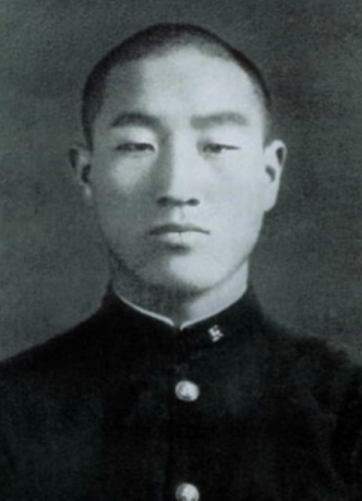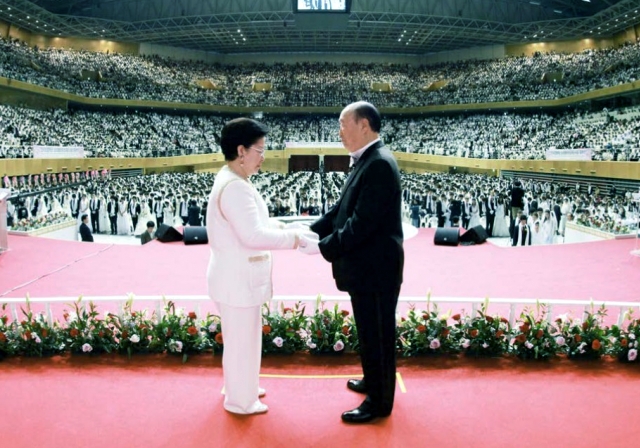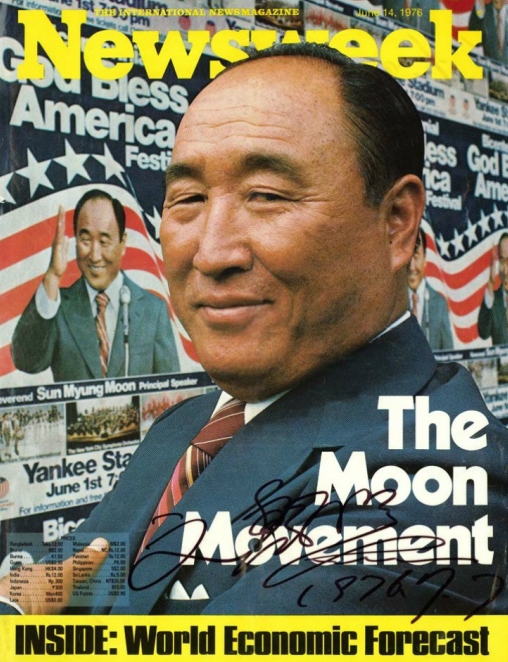![]()
The Words of the Sun Myung Moon after 2012
|
|
The Words of the Sun Myung Moon after 2012 |

Rev.
Sun Myung Moon in his high school days. In those days, Rev. Moon held
lofty academic ambitions; but he was spiritually reborn through
understanding the meaning of life and receiving his life's mission.
Through prayer and research, Sun Myung Moon discovered a God of sorrow and imprisonment... The Unification Principle clearly analyzes God's creation of human beings, the Fall and the providential process of restoration.
In 1935, when Korea was under Japanese colonial rule, Christian churches in Korea underwent a historical change. Japanese imperialism had deprived Korea of her sovereignty and was forcing Christians to worship at Shinto shrines. The Korean people stood at a crossroads. They could either reach a compromise with this reality or fight to overcome their oppression. Spurred on by the Russian revolution, the leftist faction gained power and quickly engulfed the ideological world, causing chaos and confusion. The rest of the world was left paralyzed by the Great Depression. In 1933, Hitler had just gained control of the German government; he would form the Axis Powers with Japan and Italy in 1936 and begin a full-scale military expansion. With these and other events, the world was shaking and swiftly changing.
It is said that the night is darkest just before the dawn. During the darkest time in human history, Rev. Sun Myung Moon was just beginning to understand his own mission. Rev. Moon was born on the sixth day of the first month of the lunar calendar in 1920, a year after the March 1st Movement? In 1935, in his sixteenth year, he received his mission from Heaven on Easter. Shouldering the missions of both human salvation and world peace, he set out on a rigorous life course. He passed away in the eighth month of the lunar calendar in 2012, to fulfill a "second revolution." Rev. Moon shocked the world with his impressive legacy of having evangelized 194 countries in a short period. He boldly reclaimed history and illuminated the path for humanity through countless organizations and large-scale rallies.
In 1860, in the midst of the Meiji Restoration, Japan underwent rapid militarization. While seeking to expand their power and territory; they brought victories in both the Sino-Japanese and Russo-Japanese Wars, and were waiting for the moment to pounce on the Korean Peninsula. The Japan-Korea treaty of 1876 was a stepping stone for Japan to interfere in Korean domestic affairs and become an imperialist country. This treaty was dissolved in 1910 to make way for the enforcement of the Treaty of Annexation of Korea by Japan, which reduced the Korea to a colony of Japan. The Korean people endured atrocious imperialism and humiliation, having had their long history trampled as they failed to keep up with world currents.
However, even under Japanese oppression, Korea churches were greeting the winds of change. A revival, led by Presbyterian ministers Seon Ju Gil, Ik Doo Kim and Methodist minister Yong Do Lee, became just the tonic that the Korean churches needed. At the same time, Confucian theologians were beginning to return from overseas, bringing with them new and varied trends in philosophy and theology
Notably, Rev Seon Ju Gil, who was imprisoned for two years with thirty-three other people during the March 1 Movement, brought hope to churchgoers through his ideas about eschatology and the Second Coming. Rev. Yong Do Lee professed unity with Christ, through his innovative spiritual movements during his short life of thirty-three years. He transcended denominations and kindled the fires of revival by bestowing grace upon every place he visited.

Rev.
Sun Myung Moon and Dr. Hak Ja Han Moon, president of the Women's
Federation for World Peace, gave the benediction for the brides and
grooms at the Blessing Ceremony in the Era to Open the Gates to the
Victory, Liberation and Completion of the True Parents of Heaven,
Earth and Humankind in 2012, at the Cheong Shim Peace World Center in
Gapyeong, Korea.
When viewed from a providential standpoint, Rev. Moon's appearance, just after the deaths of Rev. Yong Do Lee and Rev. Seon Ju Gil in 1934 and 1935 respectively, was not a coincidence. Why was he called by God to this mission at such a crucial turning point in history? The answer can be found in the philosophy under which Rev. Moon led his life. Even at the young age of ten, he had big dreams for the future. He had academic aspirations to obtain a doctorate degree. In the spring of 1934, at the age of fourteens he transferred to Osan Primary School in Jeongju, which is in North Pyongan Province, in what is now North Korea. There, he was exposed to theological texts for the first time. He began to view the world differently; and his standard of values and judgment developed. He began to doubt his own aspirations and hopes.
"Let's assume that I become a great scholar, attain fame and live in splendor as I wished. Would that mean anything to me? Would that be meaningful to the countless people that are suffering around me? Would my own personal success benefit anyone else? Why is humanity living amidst agony, misfortune and tragedy? What is my purpose in this situation?" These were sonic of the questions he asked himself. He also wrestled with fundamental questions such as "What is the reason that humankind lives in suffering, misfortune, and tragedy? What exactly should I be doing under these circumstances?" In his anguish, Rev. Moon's mission began to become clear to him. He resolved to liberate humankind from agony, misfortune and tragedy, and to illuminate a path and vision of an eternal, ideal world for our descendants.
He deeply pondered questions of life and the universe; and as he sought answers, he came to have a spiritual encounter with Jesus Christ. In the year that he turned fifteen, as he was praying on Easter morning, Jesus suddenly appeared in front of him. It was a revelation through which he reconfirmed his mission of saving humankind.
On October 5, 1985, Rev. Moon's wife Dr. Hak Ja Han Moon recounted this event. "At the age of fifteen, my husband was living in North Korea, where he received a series of very deep spiritual experiences. To describe in words the things he experienced at that time is difficult. To put it briefly, the spirit world suddenly unfolded in front of him, and he was able to speak with the saints and sages of that world. In the tranquil mountains of North Korea, my husband had several spiritual conversations with Jesus Christ."
Rev. Moon revealed through prayer and research that God was not a glorious God, but rather a sorrowful and imprisoned one. He confirmed that after the Fall, God had been engulfed in sorrow and tears as he searched throughout history to find his lost children. This is how Rev. Moon came to devote his life to the liberation of God and to seek universal truths.
Rev. Moon discovered the Divine Principle, the new truth that would reform the people of the world. With the Divine Principle as the foundation, he planned to guide the world to do God's work. After receiving his mission from God, he devoted every second to elucidating the Divine Principle and establishing Unification Thought!
While studying abroad, in Japan, he kept three Bibles open on the desk in his room -- one in Korean, one in Japanese and one in English. To capture the fundamental essence of the Principle, he invested his whole heart and sincere prayer into understanding its rules and processes. He cross-referenced the Bible to books on science religion and philosophy in order to make his findings accessible to all people. Scientifically investigating the whole providential truth of God and digging up the roots of Christianity were not easy tasks. Rev Moon remembers God as having been cold and merciless toward him at that time. If God had openly shown him affection, it could have become an opportunity for Satan to slander and attack him, so instead he had to pioneer that path alone.

On
June 14, 1976, Rev. Sun Myung Moon was featured in the weekly
magazine Newsweek for his international evangelical work. "The
Unification Church's interpretation of the Bible can be seen as
simply a different approach to Christianity,' expressed the Rev. Won
Ryong Gang at a 1968 seminar at the Christian Academy House.
Rev. Sun Myung Moon was most curious to understand the origin and basis of the universe and of humankind. After years of struggle in prayer, the answer that God gave was this God and humankind are in a parent-child relationship. From that day, the core teaching of the theology became God is our parent, and we are his children. He has since dedicated his whole life to advocating the philosophy of true love.
Rev Moon wrote Wolli Wonbon, the original text and foundation for the Divine Principle, when he was living as a refugee in Busan. Beginning with the line, "All things originate from the same source," Wolli Wonbon was written over the course of about a year, beginning in May 1950. It is said to be the beginning of the Divine Principle. In 1957, seven years after he wrote Wolli Wonbon in pencil, the Explanation of the Divine Principle was released, and within a further ten years, by 1966, Exposition of Nee Divine Principle was finally published. The process for recording the truth is explained on page twelve in the preface of the Exposition of the Divine Principle.
In the fullness of time, God has sent one person to this earth to resolve the fundamental problems of human life and the universe. His name is Sun Myung Moon. For several decades, he wandered through the spirit world so vast as to be beyond imagining. He trod a bloody path of suffering in search of the truth, passing through tribulations that God alone remembers. Since he understood that no one can find the ultimate truth to save humanity without first passing through the bitterest of trials, he fought alone against millions of devils, both in the spiritual and physical worlds, and triumphed over them all. Through intimate spiritual communion with God and by meeting with Jesus and many saints in Paradise, he brought to light all the secrets of Heaven.
Exposition of the Divine Principle covers three major themes: "The Principle of Creation," "The Human Fall" and the principle of restoration. Other areas covered include "Eschatology and Human History," the Messiah: His Advent and the Purpose of His Second Coming, Resurrection, Predestination, Christology and the Second Advent.
The core teachings of the Unification Principle are revealed in the chapter, "The Principle of Creation." The relationship between God and human beings, the purpose of the creation of human beings and of the incorporeal world (the world after death) are explained in detail in this chapter. This chapter reveals that the purpose for which God created human beings was to obtain individual perfection of one's character, which is necessary to substantiate a true family centered on God, in order to return joy to him. It also states that all beings contain the dual characteristics of an internal character and an external form, and positivity and negativity; and that God created human beings in his image as his substantial object partners. Furthermore, humans were originally to enjoy life in the substantial world death, when they shed their physical bodies and pass into heaven in the incorporeal world, to enjoy eternal life.
'The Human Fall" concretely explains the root of sin that caused all of humanity to descend into contradiction and misfortune. It also outlines the method of eliminating sin in the world and of bringing about a good world. Satan seduced our first human ancestors when they were still in a period of immaturity, and they fell through adultery. The chapter emphasizes that if the standard of love is properly established and a true family is formed, an ideal world can be established on earth for the first time in history.
Eschatology explains that the "end of the world" does not refer to the literal end of the world but to the collapse of the authority of sin, as well as the turning point that will establish a true world of goodness, centered upon God on earth -- the era of hope. Therefore, history has comprised the course of providential salvation and restoration in an attempt to restore what was intended and complete God's original purpose of establishing heaven on earth.
The principle of restoration explains in detail the process of God's providence of salvation, which he established in order to restore the world to the ideal he envisaged at the time of the Creation and reclaim his children from the usurper Satin. The principle of restoration explains the miserable situation of God, who had no choice but to take slow, agonizing steps establishing central figures throughout history for the providence of salvation.
The Divine Principle received great attention for depicting God differently from Christianity's cryptic God through its explanation of the creation of humans, of the Fall and of the providential course of restoration. It overcame the limits and sticking points that could not be explained to atheists or materialists by mainstream religions.
Because modern people live in an era that focuses on science and logic rather than on values, the Divine Principle is highly praised for presenting a systematic, concise view of God, of life of history and of the world.
Rev. Sun Myung Moon's Divine Principle is a topic of interest within religious circles as well. During a three-day public philosophy course held from October 13, 1969 at the Saemunan Presbyterian Church in Seoul, the late philosopher Nam Dong Seo, a retired Yonsei University professor; discussed the Exposition of the Divine Principle during a talk entitled, "The Critical Research of the Unification Church's Exposition of the Divine Principle." Baekseok University Professor Kyung Bae Min described the talk in this way in his book, Korean Christian History, "Professor Nam Dong Seo's research on the Unification Church caused a rare stir in Korean church circles. Professor Seo is a bright, sensitive theologian and the foremost leader in tackling the problems of the modem world within the Korean church, through theological explanations. He described the Divine Principle of the Unification Church as `the most extensive, organized, creative and original piece of theology written by a Korean theologian. It has become a source of renewed energy and new hope for the world's churches.'"
Even at the New Religious Research Seminar at the Christian Academy House in the Ui District of Seoul, September 9-10, 1968, the Divine Principle received high praise. At this seminar, the Unification Principle was introduced for the first time to about forty respected Christian leaders, including Christian Academy Director Rem Won Ryong Kang; Jae Joon Kim, the dean emeritus of Hanshin University; Methodist Theological University Dean Hyeon Seol Hong and Central Theological University Dean Byeong Mu Ahn. "I have waited for a very long time for this opportunity" said Rev. Moon. "I hope that today can provide the incentive to break down the wall between new and established religions, and that we can join hands to accomplish the vast task of the providence together as one."
Rev. Won Ryong Kang, after listening to four Divine Principle lectures, stated in the day's press report, "The Unification Church's interpretation of the Bible can simply be seen as a different approach to Christianity. Contrary to the deductive interpretation of the Bible by established churches, the Unification Church uses inductive reasoning to explain the Bible."
The Unification Church offers a very logical and reasonable interpretation of the Day of Judgment. This philosophy of the Last Days comes across to the people of today, who are surrounded by feelings of danger," remarked Dean Hong.
The "Unification Principle Open Hearing," attended by about two thousand Protestant ministers, also received a fervent response. This feverish attention caught on among clergymen overseas; between April 1985 and July 1988, approximately eight thousand American clerics visited Korea to attend fourteen Divine Principle seminars. The Divine Principle began to make waves throughout the world as it solved the most pressing issues of modem society, cleared up religious conflicts and established its place among religious movements as a legitimate alternative philosophy.
As he prayed and pondered deeply about the questions of life and the universe on Easter morning, Jesus suddenly appeared to the fifteen-year-old youth. It was a revelation in which he received the mission of saving humankind.